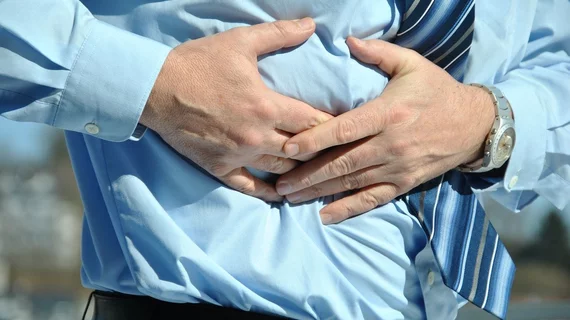Emergency abdominal CT scans decrease markedly during the pandemic, while prognoses worsen
Emergency department visits and abdominal CT scans have declined during the pandemic, while prognoses have worsened, experts reported Thursday.
Several studies have already documented the widespread drop in imaging amid calls to postpone care during the pandemic. But a fresh analysis in JACR has now documented the declining condition of patients presenting in the ED with stomach pain. The results, noted researchers with the universities of Toronto and Ottawa, could have important ramifications for future COVID-19 outbreaks.
Comparing year-over-year emergency imaging trends, scientists discovered a 42% drop in abdominal CT exams and 47% dip in net ED visits when compared to the same period in 2019. Meanwhile, scans showing complications increased significantly, as did cases requiring surgical intervention.
“This information has important public health implications and highlights the need to educate patients to continue to present to hospital services during such crises, or indeed if a purported second wave arises,” Ciara O’Brien, with the Department of Medical Imaging at University Health Network, and colleagues reported Aug. 20.
To make their determinations, the team analyzed 733 patient encounters at a single ED, logged between March and April of 2019, and compared them to 422 during the same period in 2020. They noted a nearly 18 percentage-point increase in the number of CT scans with positive findings (up to 50.5%) in 2020. Complications also increased during the pandemic by nearly 12 percentage points (to 19.7%), while those requiring surgery leapt from 26.3% to 47.6% this year.
It’s unclear why ab CT prognoses appeared worse during the pandemic, O’Brien et al. wrote. However, they hypothesized that some may have ignored their symptoms longer, resulting in increased complications. For instance, the team reported a higher number of complicated appendicitis cases (39% this year versus 20% in 2019) and bowel obstructions (30% compared to 6%).
The study is limited by its single-center nature and other factors. But the team believes it warrants attention, amid concerns of delayed care and its downstream consequences.
“The onus is on the government, media and healthcare institutions to publicize the measures undertaken to ensure patient safety during the pandemic and reduce anxiety associated with presenting to hospital when in need of any type of medical attention,” O’Brien wrote.
Read more of the pre-proof piece in the Journal of the American College of Radiology here.

